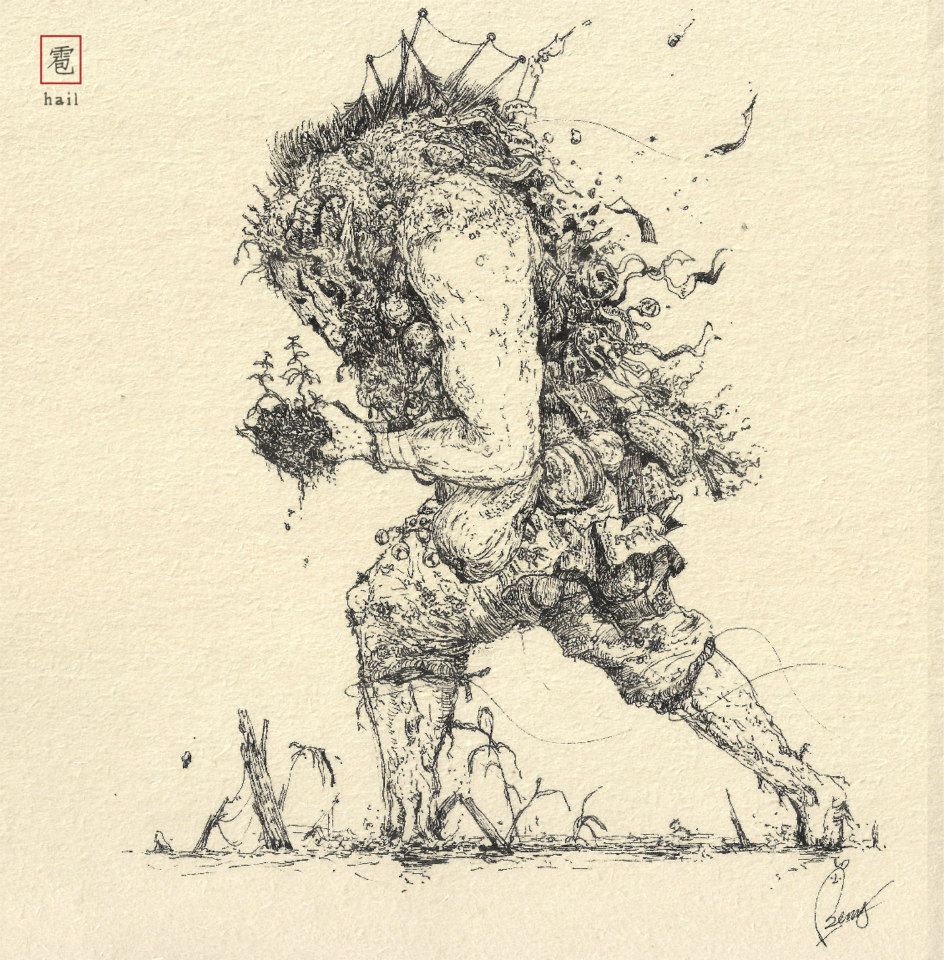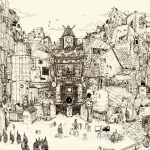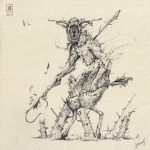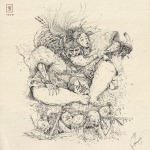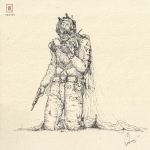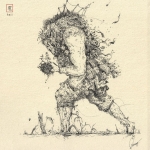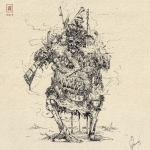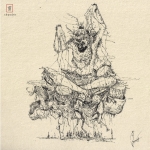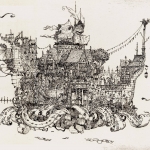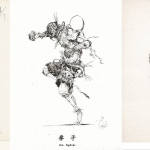Every morning Yi-Yang Chen gets out of bed, whips up some breakfast and hops on his bike to pedal his way to work. It’s during that thirty-minute bike ride that Yang begins to generate ideas for his next illustration; quietly observing the animated characters, buzzing neon neighborhoods and temples that line the 300 year old streets of Taipei. With each block he passes and each face he encounters, a new narrative begins. It’s these imagined narratives – conjured not only on a causal walk or bike ride, but from his interactions while traveling – that spawn Yang’s finite illustrations.
Think of Yang as a fly on the wall; going unnoticed while carefully watching strangers and his surrounding elements. He observes emotions, facial expressions and scenery, and accordingly crafts emotional stories that he then brings to life through intricate and painstakingly detailed illustrations. For Yang, the stories stand as the pillar to his process. Without the words or stories, Yang feels as if his pieces are simply a bunch of complex lines on a worn out piece of paper.
A natural observer with chameleon-like candor, Yang’s work is informed by not only his vast Chinese culture – drawing on Chinese dramas and Taiwanese temple culture – but also the artistic traditions of vastly different cultures including Turkish, Peruvian, Japanese and Tibetan. Enamored by complexity, Yang uses the utmost detail in his pieces in order to visually articulate the complex notions and imagery in his mind. Each precise and scrupulous mark made by his Rotring 0.2 pen sparks a highly meditative experience for Yang, as he confronts ideas surrounding Zen (禪), and reflects on concepts about fate, self-confidence and ambition in each of his illustrations.
What comes first, the idea for the story, or the illustration?
It depends on what i’m drawing. Basically I get topic first, then start to get ideas and start to draw. Sometimes ideas come so fast that I have to record it immediately, but sometimes they just won’t show up. When there’s no main idea for the topic, I’ll do the drawing first. The funny thing is, most of the stories behind my works were completed just before the drawing was done; like I finish them at the same time.
Almost all of your illustrations include text, usually an accompanying storyline – how important is the text to each piece?
Yup! The stories for each piece bring the illustration to life; without words and stories, the piece is just a bunch of complex lines on the paper. The stories do influence my work, the look of the piece changes when the story is modified. Sometimes the final piece will be totally different from the first sketch. And that’s why I love drawing.
Tell us a little more about your background and your style. How has your artistic background led to the style you are working in now?
I grew up in a really nice family, my parents never forced me to draw, and never stop me drawing. I remember that when I was a child, my mom always would put a stack of paper in the living room so I could draw till my hand went sore. When I grew up, I started to carry a notebook around with me. Whenever I was drawing, I would never feel bored.
I traveled to Shanxi and started my first journey with sketches. The more sketches I did, the more certain I was that I had to get more in touch with my Chinese and Taiwanese culture. For many years, I felt like I was a man without culture. When I got back home I drew the project, “The Stage Around the World,” which used the elements I saw during my journey to Shanxi to build an illustrated collection from imagination. “The Stage Around the World” is done completely by line work. Since then, I love to use line work to create my pieces because it’s clear and I can show all the details in my mind precisely.
I travelled more, not only exploring Chinese culture but Turkish, Peruvian, Japanese, Tibetan… I realized that I’m not only Chinese, but rather a world’s citizen. So I started to draw on a range of different cultures for my work. Now I design characters, tribes and things with world-wide element, trying to tell people that the world is fantastic.
Do you think your illustrations would still translate properly if they weren’t as detailed? Is it sort of meditative to work in such a detailed manner?
A boy won’t need any patience for video games – that’s the same situation for me when I’m drawing all the details. When I was a kid, I loved to draw snakes because of the scales they have. From there I became even more attentive to all the small elements of larger images, including machines, crops, natural elements, fur… I’m addicted to those complex things. In addition, drawing them made me calm. I’m so concentrated while detailing that I can hear the sound while my pen touch the paper, it sounds really good. I always feel excited and healed when a detailed piece is done, I guess that’s the most important reason for me to keep on with the detail manner.
But if my work was not detailed, I guess it will lose some of my ideas, but not the main emotions. The emotions that an image gives you is not because of details, but the story of it and the first look. When works go complex, it’s time to simplify them. That’s what I believe and what I’m still working on.
Why no color?
Because I think colors would cover details that I’ve done. Another reason is that I try to keep the beauty between line work and paper, it’s more like traditional method and it’s pure and strong.
Tell us a little about Chinese illustration, how does your work fit within the Chinese style? What do you think is particularly Chinese about your style?
I love the face painting of Chinese dramas and Taiwanese temple culture. They use face painting to let people know the characters’ personalities and their story from the first look. I thinks that’s what makes it so different from other cultures. Also, that’s the reason why many of my characters are in face-painted style. In addition, designs also came from other cultural traditions of China and Taiwan. I used to put in drama elements, and now I want to use more temple culture, which are more Taiwanese.
But the most “Chinese” part of my piece is the story behind the image. Despite my not knowing much about Zen (禪), I still try to tell stories that include the idea. Many of my stories are about fate, self-confidence and ambition, things I believe in and live my life by.
Where do you live specifically? How do your surroundings influence your work?
Actually I live in Taipei because of work, but I always say that I’m from Hsinchu, where my home town is, haha. I say that because I’m a little bit sick of big cities. Countrysides like Hsinchu County are really the places that influence me more. Things in the countryside are warm, peaceful and more natural, and that’s the energy I need for my illustration. In addition, people in countryside also have a healthy spirit; they live on real life, and fit into the environment. I think that’s how a person should live and fit in with the environment.
I still get some ideas from Taipei and other big cities, but most of them are sad stories. Differences between the countryside and the city is interaction. People in city don’t talk to strangers, not even a smile on their face. However, people in the countryside are much friendlier and love to share. That’s how I get ideas for new works.
Can you pick out three of your favorite places to find recluse in your city? Do you think it’s important to find a quiet place when creating your pieces of work or are you able to work creatively under any conditions?
The most comfortable environment in the world would beIt’s my room back in Hsinchu. I feel relaxed and highly concentrated with drawing. Actually, I can do drawing under any conditions (but not on a shaky car). The most important condition for me to draw is not based on how quiet a space is, but rather the things going on in an environment, that’s when ideas are triggered in my mind. Also, music I listen to has a huge influence on my work.
Tell us about your most current work, what is the significance of the red box with the Chinese character in it that sits in the upper left hand corner of your new pieces?
For my new series, the topic is weather. I tried to personify the weather through character design and illustrations. Each character depicts a specific weather pattern or climate. The Chinese word in the upper left hand corner shows the name of the weather. In Chinese, words about weather are related to character – “雨 (rain)” – and that makes a strong connection between each piece. Also, each Chinese word has its own meaning, and the red box in the corner is to strengthen that idea. The red box is really common when practicing Chinese characters in childhood, just like calligraphy. It’s a symbolic icon in our beautiful culture.
For more from Yi-Yang Chen follow him on Instagram and Facebook.
BESbswyBESbswyBESbswyBESbswyBESbswyBESbswyBESbswyBESbswyBESbswyBESbswyBESbswyBESbswyBESbswyBESbswyBESbswyBESbswyBESbswyBESbswyBESbswyBESbswyBESbswy

